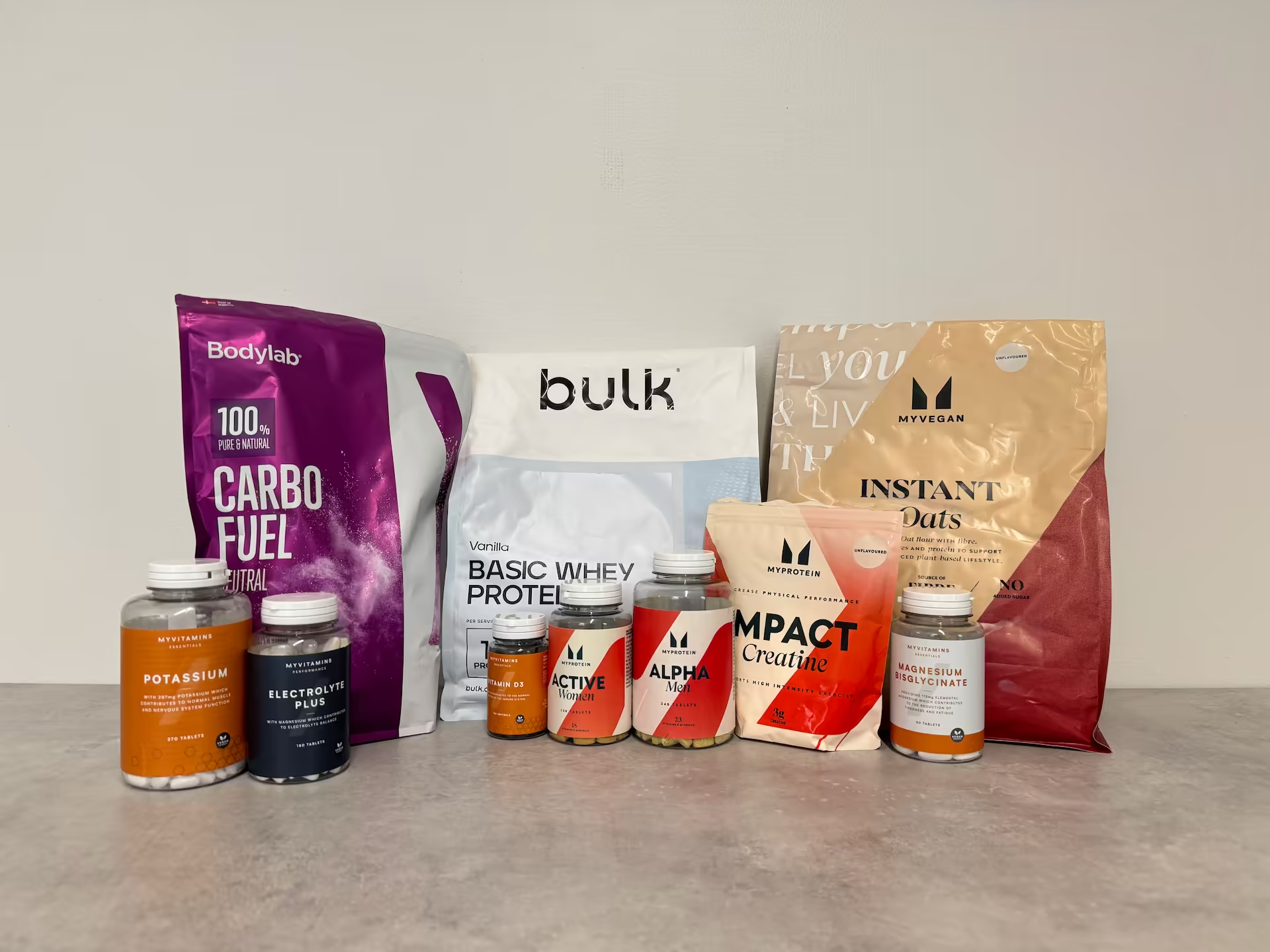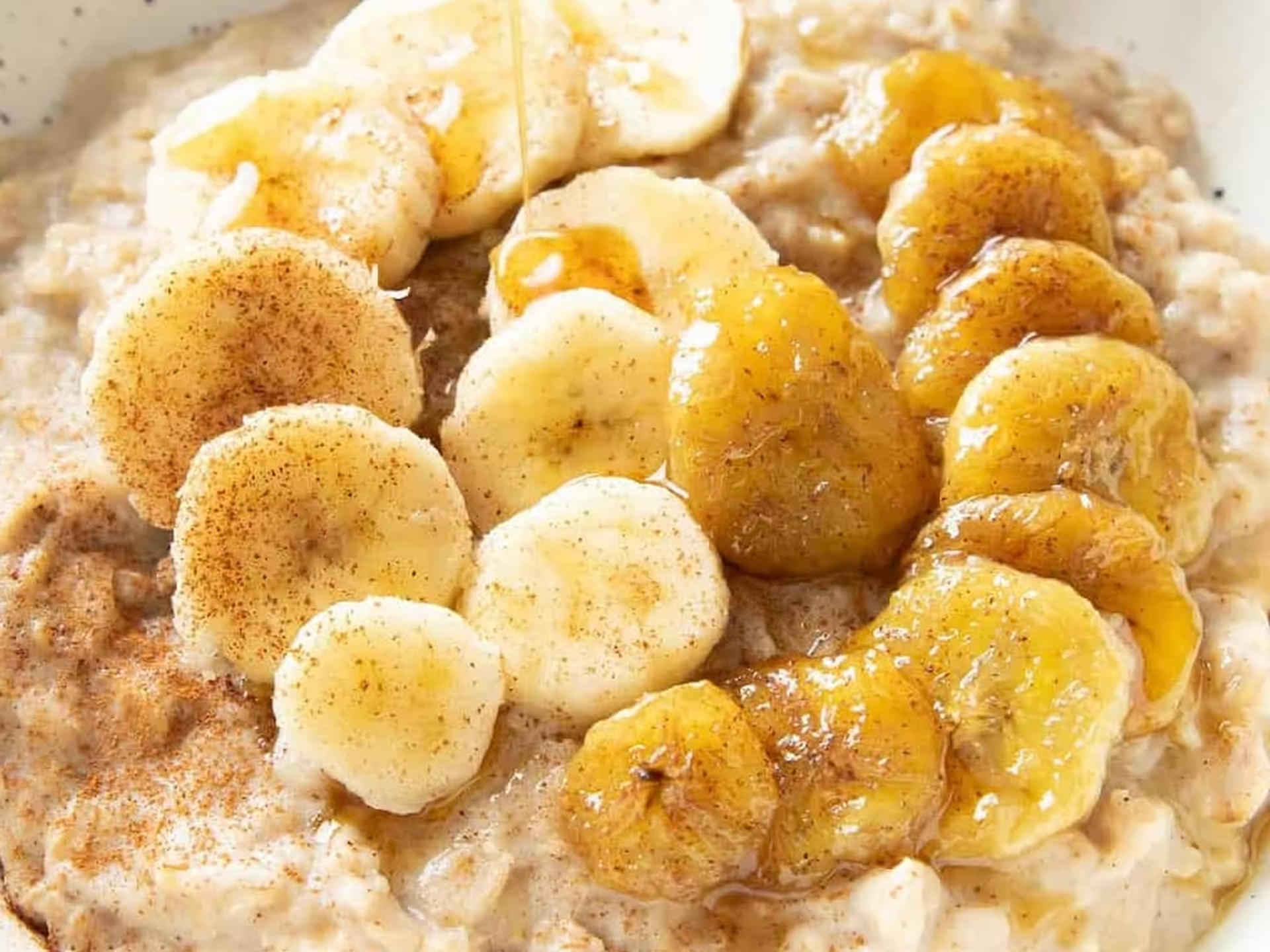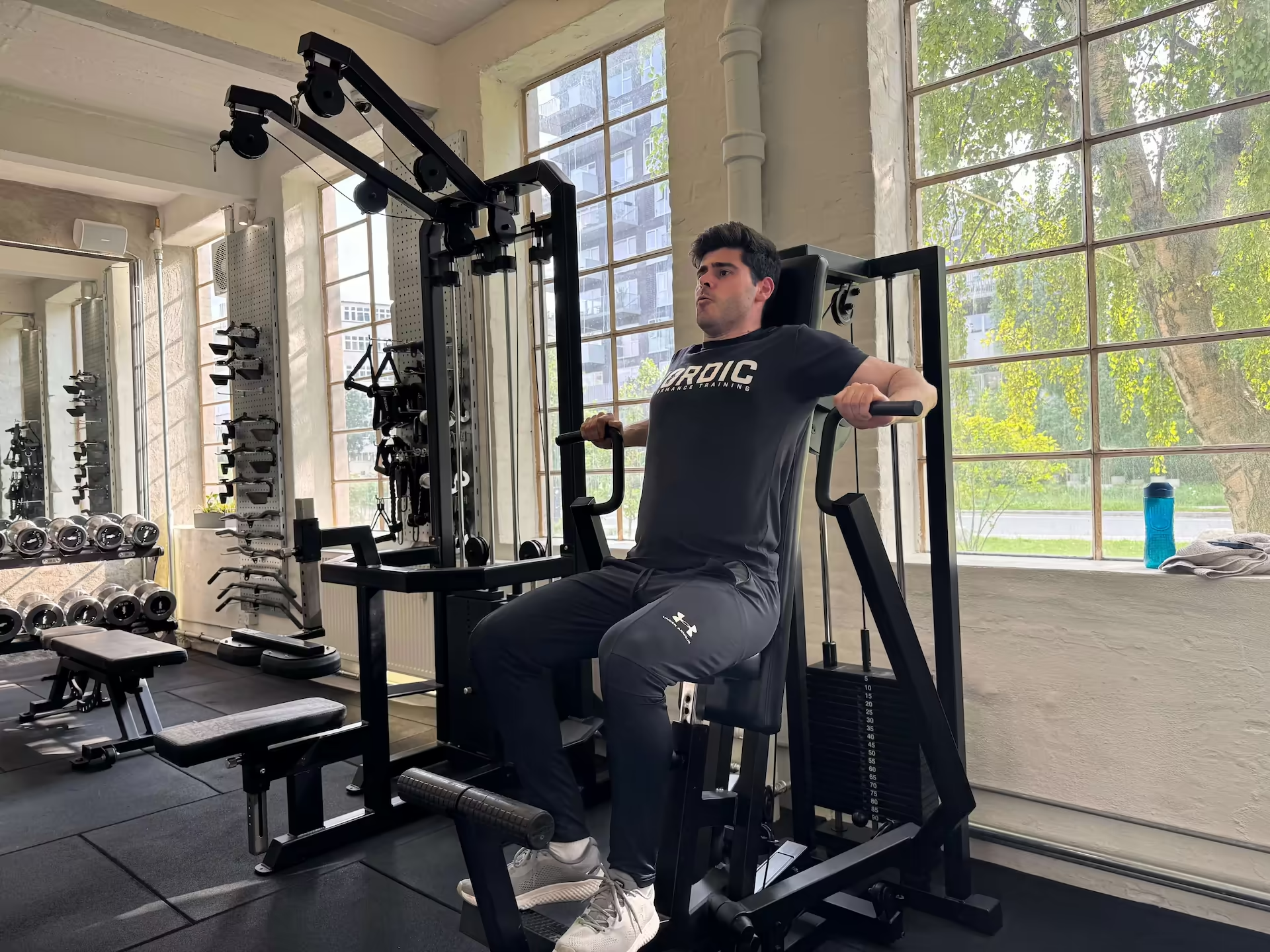Top 5 Muscle-Building Nutrition Tips – Maximize Your Results
With over 10 years of experience as trainers and physiotherapists and more than 3,000 clients at Nordic Performance Training, we know exactly what it takes to build muscle through diet and nutrition.
Nutrition alone doesn't build muscle – strength training does. But without the right nutrition, even the best training won't deliver optimal results. We see it again and again: people train effectively but lack the simple dietary adjustments needed to see progress.
If you want to maximize your training, read our Full Body guide, where you'll also find 3 free training programs.
Why nutrition is crucial for muscle building
Muscle building requires three things: training stimulus, rest, and nutrition. All three must be in place. Our experience with thousands of clients shows that nutrition is often the missing piece for people who train hard but don't see results.
This guide gives you the five most crucial nutrition tips without unnecessary details. Let's get started.
1. Eat enough protein – 1.6–2.2 g per kg body weight daily
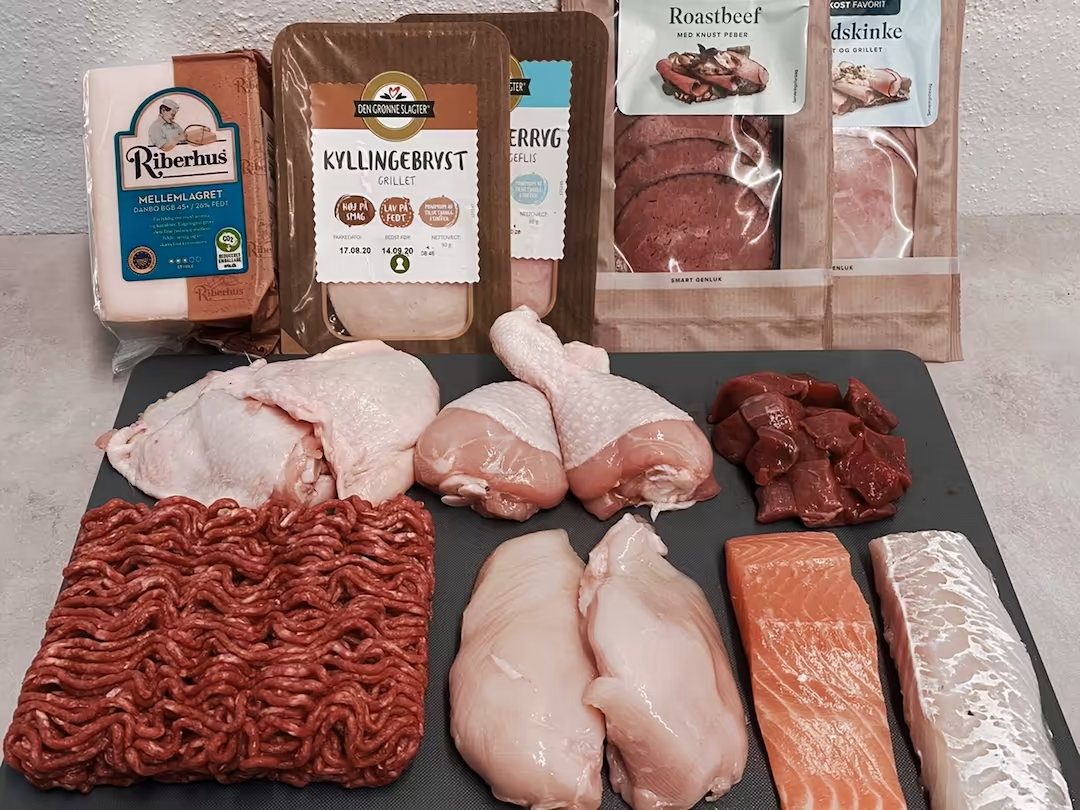
How much protein should you eat?
The most important factor for muscle building is sufficient protein intake. Based on the latest research, we recommend 1.6–2.2 g protein per kg body weight daily.
Practical protein calculation
- 50 kg person: 80–110 g protein daily
- 60 kg person: 96–132 g protein daily
- 70 kg person: 112–154 g protein daily
- 80 kg person: 128–176 g protein daily
- 90 kg person: 144–198 g protein daily
- 100 kg person: 160–220 g protein daily
Why exactly 1.6–2.2 g/kg?
Optimal muscle growth: Meta-analyses show that this interval gives the best results for both strength and muscle mass.
Muscle preservation during weight loss: Higher protein intake helps preserve muscles when you're in a calorie deficit.
Satiety and energy: Protein increases the feeling of satiety and has a thermic effect of 20–30%, so the body uses more energy to digest it.
Safety: Studies show no documented side effects at intake up to 3–4 g/kg in healthy individuals.
Client case: Too little protein slows progress
A 32-year-old IT consultant came to us after 8 months of regular strength training without visible results. We asked about his diet and found out that his daily protein intake was only around 0.8 g/kg body weight – approximately 65 g in total.
We helped him with simple adjustments:
- Larger portions of the protein sources he already used
- 2 scoops of protein powder as a practical supplement
This raised his intake to 1.8 g/kg (145 g daily). Combined with our Full Body program, he began to see significant muscle growth after a few weeks.
Typical consequences of too low protein intake
- Slow or absent muscle growth
- Poor recovery between training sessions
- Increased risk of injuries
- Loss of muscle mass during weight loss
Benefits of higher protein intake (the upper end)
Why we often just recommend 2 g/kg. This provides:
- Greater feeling of satiety – easier to control appetite
- Higher energy expenditure during digestion
- Better muscle preservation
- Safety margin for busy days without compromising results
Important note: This applies to healthy individuals. If you have kidney problems or other medical conditions, you should always consult your doctor before increasing protein intake.
Read possibly our Protein Powder guide.
2. Choose mixed protein sources – quality and quantity
The table below shows how much protein is found in common animal and plant-based foods. The animal sources have a complete amino acid profile and high bioavailability, while the plant-based ones can be combined to achieve the same effect.
Use the table as a practical reference when planning your meals or adjusting your daily protein intake.
Protein sources – animal vs. plant-based (per 100 g)
Animal vs. plant-based protein sources – what should you choose?
Both types can support muscle building effectively. Animal proteins typically have higher bioavailability, while plant-based ones provide more fiber and micronutrients. For most people, a combination works best in practice.
When we work with clients, we recommend starting with the most practical and reliable sources — foods you actually want to eat every day.
Practical protein meals
It's not about eating perfectly, but about finding solutions you can repeat every day. Below are some simple meals that provide around 30–40 g protein per serving.
Breakfast (~30–40 g protein):
- 3–4 eggs + 150 g Greek yogurt with berries
- 75 g oats + 30 g protein powder + 250 ml milk
See our article: 5 High-Protein Breakfast Recipes for more ideas
Lunch (~40 g protein):
- 150 g chicken breast + 200 g rice + vegetables
- 200 g salmon + sweet potatoes + salad
Dinner (~40 g protein):
- 150–200 g meat/fish + potatoes/rice/pasta + vegetables
Quantity more important than source
Although animal proteins have a more complete amino acid profile, research shows that total daily protein intake is far more important than the individual source.
Plant-based athletes can achieve the same muscle growth as athletes who eat animal foods, as long as total intake is high enough.
Practical advice: Mix different protein sources throughout the day – combine e.g., legumes with grain products – to ensure a complete amino acid profile.
3. Prioritize carbohydrates – your fuel for training
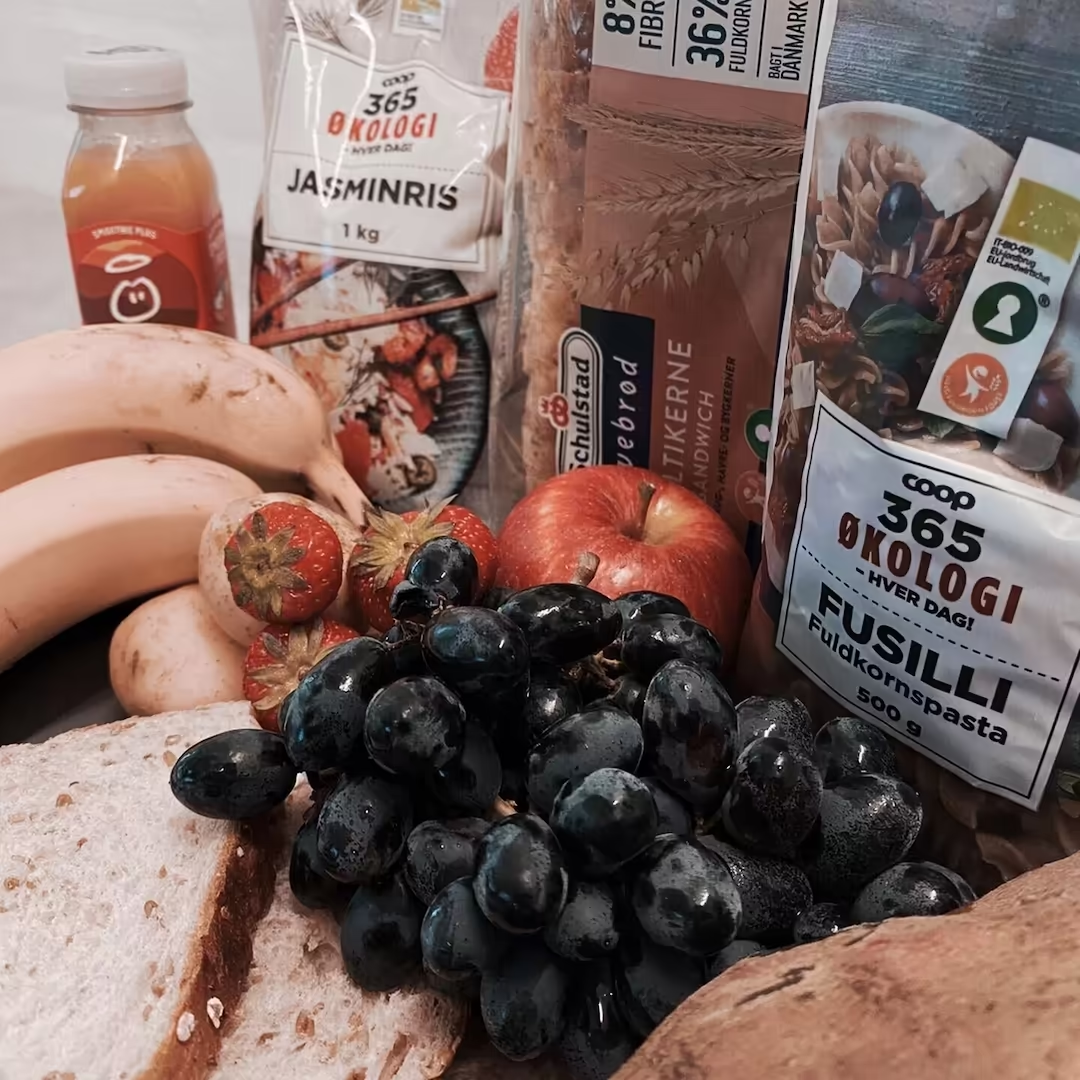
Carbohydrates aren't absolutely necessary to build muscle – but they make the process far more efficient. They provide energy for training, improve recovery, and ensure that the protein you eat is used for muscle building instead of energy.
The role of carbohydrates in muscle building
- Fills glycogen depots: More energy for the next training session
- Drives performance: Fuel for heavy lifts and intensive sets
- Protein-sparing effect: The body uses carbohydrates as energy instead of protein
- Supports hormones: Including insulin and IGF-1, which are important for muscle growth
Without carbohydrates: The body begins to convert protein to glucose (gluconeogenesis). This "steals" protein from muscle repair – inefficient if the goal is growth.
Before training: Prioritize carbohydrates + protein
Full meals (2–3 hours before):
- Oatmeal with milk
- Rye bread with protein-rich toppings
- Rice with lean meat and vegetables
- Pasta with meat sauce
Goal: 40–80 g carbohydrates + 30–50 g protein
Light snacks (30–60 minutes before):
Perfect for morning training or when there's no time for a full meal.
- Skyr with fruit + muesli
- Protein shake + banana
- Oats with protein powder
- Instant Oats (blended oats) + protein powder
Goal: 40–60 g carbohydrates + 30–40 g protein
Read more in our guide: Best pre-workout meal before strength training
After training: Prioritize protein + carbohydrates
Focus after training:
- Protein first – give the body building blocks for muscle building
- Carbohydrates to refill energy depots
Important point: You have 48–72 hours to replenish glycogen before you train the same muscles again. So no stress – prioritize protein after training.
Quick snacks (on the go):
- Chocolate milk
- Protein shake + fruit
- Drinking yogurt
Goal: 20–30 g protein + 20–30 g carbohydrates
Complete meals (within 2–3 hours): Same examples as before training – just focus extra on the protein sources.
Goal: 25–40 g protein + 40–80 g carbohydrates
Client case: Significantly better energy with carbohydrates
A 33-year-old consultant trained every morning but often skipped breakfast and trained fasted. The result: low energy, declining strength, and the feeling of being "flat" during training.
We changed one thing: he started drinking a shake with 1 scoop instant oats (approx. 40 g) + 1 scoop whey protein powder + 300 ml skim milk around 45 minutes before training.
Note: You can advantageously add 5 g creatine to this shake.
After two weeks, he experienced:
- More energy for heavy sets
- Greater training volume (more sets with the same weights)
- Better recovery the day after
The point: Small changes in carbohydrate timing can give noticeable results – without making the diet complicated.
Carbohydrates during training (only when needed)
Relevant for:
- Training sessions over 90 minutes
- Double sessions on the same day
- Athletes with very high training volume
- People with tendency toward low blood sugar
Practical sources:
- Sports drink with glucose/maltodextrin
- Juice
- Banana
Goal: 20–40 g carbohydrates per hour
4. Optimize timing and meal frequency
Many believe you must eat constantly to build muscle – but newer research shows that the most important thing is total daily intake, not how many times you eat.
How many meals per day?
The table shows approximately how much protein you should have per meal depending on your body weight and how many meals you eat daily. The numbers are rounded for easy use.
Optimal: Minimum 3 protein-rich meals daily to optimally stimulate muscle protein synthesis. But it's better to be consistent with 2 large meals than inconsistent with 4–5 meals.
Client case: Protein distribution makes a difference
A 29-year-old client came to us after a year of regular strength training – without visible results. We structured his strength training better, and when we asked about his dietary habits, it turned out he got most of his protein in one large evening meal.
After we changed to 3–4 meals with ~40 g protein in each and optimized his strength training, he began to feel faster recovery and see visible muscle growth after 8 weeks.
Pre- and post-workout timing
Pre-workout (1–2 hours before):
- 30–50 g protein (~0.4–0.6 g/kg for 80 kg person)
- 40–60 g carbohydrates (~0.5–0.75 g/kg)
- Low fat content (fat delays digestion)
Post-workout (within 2–3 hours):
- 25–40 g high-quality protein
- 30–60 g fast-absorbing carbohydrates
Summary timing: You don't need to eat every 3 hours – but distribute your protein over at least 3 meals, eat a protein and carbohydrate-rich meal 1–2 hours before training, and get both protein and carbohydrates within 2–3 hours after.
5. Eat sufficiently – but cautious calorie surplus
Calorie surplus based on body weight
A simple way to estimate your maintenance intake is to multiply your body weight (kg) by 35–40 kcal. For muscle building, a moderate surplus of 200–400 kcal/day is added.
Important: These calculations are very imprecise and can quickly create an unnecessary need to see your food in numbers, which can become problematic in the long run.
Our recommendation at Nordic Performance Training: Simply eat a little more than you usually do if the goal is muscle growth, and adjust based on weight development over time.
Realistic weight gain goals
- Beginners: 0.5–1 kg per month
- Experienced: 0.25–0.5 kg per month
- Women: 25–50% of men's rates
Warning: Faster weight gain primarily results in fat gain, not muscle. A calorie surplus of 250–500 kcal/day is normally appropriate.
Macronutrient distribution
This table shows an example of how a daily calorie intake of approximately 2,810 kcal for a person of 80 kg can be distributed between protein, carbohydrates, and fat, so it supports muscle building, recovery, and energy for training. The numbers are indicative and can be adapted according to individual needs and preferences.
Practical approach:
- Calculate protein needs first (1.6–2.2 g/kg)
- Set fat to 25–35% of calories
- Fill the rest with carbohydrates
Bonus: Vitamins, minerals, and supplements
400–600 g fruit and vegetables daily
Micronutrients don't directly build muscle but are critical for:
- Optimal recovery
- Immune system during hard training
- Energy production in cells
- Anti-inflammatory processes
Practical distribution:
- Breakfast: 100 g berries/fruit in skyr/oatmeal
- Lunch: 100–200 g vegetables/salad
- Dinner: 100–200 g vegetables/salad
- Snacks: Fruit between meals
Most important micronutrients
- Zinc: Testosterone production and protein synthesis (meat, fish, nuts)
- Magnesium: Muscle contraction and protein synthesis (green leaves, nuts, seeds)
- Vitamin D: Hormone regulation and muscle strength (sun, fatty fish, supplements in winter)
- Iron: Oxygen uptake to muscles (red meat, green leaves, legumes)
Supplements that can help
Creatine – documented effect:
- 5–15% increase in maximum strength
- Accelerated muscle growth
- Improved training volume
- Dosage: 5 g daily (timing irrelevant)
- Price: 20–30 kr/month
Protein powder – practical, not necessary:
- Relevant if you don't reach protein goals through food
- Practical post-workout or between meals
- Dosage: 30–50 g per portion
- Price: 200–400 kr/month
For a complete supplement guide, read What are supplements? – or if you want quick, practical advice, read Top 5 Best Supplements for Health and Training.
The 3 biggest myths debunked
Myth 1: "You must eat every 3 hours"
Fact: Meal frequency has minimal significance. Total daily intake is crucial.
Myth 2: "Carbohydrates in the evening turn into fat"
Fact: Only calorie surplus creates fat increase. Timing of carbohydrates is less important.
Myth 3: "Plant protein is inferior to animal"
Fact: With sufficient intake, plant protein can give the same muscle growth as animal protein.
Frequently asked questions about muscle building and diet
Can I build muscle without a calorie surplus?
Yes, it's possible – especially for beginners and people with higher body fat percentage. But the process is slower and more challenging. For most effective muscle building, a slight calorie surplus is recommended.
How quickly can I expect to see results?
Typically, you can see visible changes after 4–6 weeks, feel measurable progress after 8–12 weeks, and significant muscle changes often occur after 6 months or more with consistent training and diet.
Should I count calories and macronutrients?
It can be a good idea to count in the beginning to learn portion sizes and ensure enough protein intake. After 2–3 months, many can adjust diet more intuitively while still reaching their nutrition goals.
What protein intake is recommended for optimal muscle growth?
Generally, 1.6–2.2 g per kg body weight daily is recommended. Distribute it evenly over 3–5 meals to optimize muscle protein synthesis.
Start your new muscle-building nutrition plan today
Simple 3-step strategy
- Step 1: Calculate your protein needs (body weight x 2)
- Step 2: Distribute protein over 3–5 meals daily
- Step 3: Add 200–400 calories to your maintenance intake or eat a little more than you usually do
Example daily menu (80 kg person)
This daily menu shows how you can translate your macros into practical meals that support muscle building. The menu shows approximately:
- 2,810 kcal
- 167 g protein (25%)
- 290 g carbohydrate (45%)
- 96 g fat (30%)
The goals are only indicative – you can adjust portion sizes or swap ingredients so it fits your taste and everyday life.
Remember that persistence over time is more important than perfection in every meal. Use this menu as inspiration but adapt according to hunger, desire, and needs, and be flexible. Small changes don't negatively affect your muscle growth as long as total daily protein and calorie surplus are roughly in place. There's approximately 30% uncertainty in product declarations, so don't stress about hitting exactly – focus on persistence over perfection.
Want personal guidance?
Want personal training where we help you build a solid training routine while guiding you to simple and easy dietary adjustments that give results – without it taking over your life?
Book a free start-up conversation at Nordic Performance Training, where together we'll create a plan that fits your goals and your everyday life.
References
Schoenfeld, B.J. & Aragon, A.A. (2018). How much protein can the body use in a single meal for muscle-building? Implications for daily protein distribution. Journal of the International Society of Sports Nutrition, 15(1), 10. https://pubmed.ncbi.nlm.nih.gov/29497353/
Helms, E.R., Zinn, C., Rowlands, D.S., & Brown, S.R. (2013). A systematic review of dietary protein during caloric restriction in resistance trained lean athletes: A case for higher intakes. International Journal of Sport Nutrition and Exercise Metabolism, 32(6), 421-436. https://pubmed.ncbi.nlm.nih.gov/24092765/
Kerksick, C.M., Wilborn, C.D., Roberts, M.D., et al. (2018). ISSN exercise & sports nutrition review update: Research & recommendations. Journal of the International Society of Sports Nutrition, 15(1), 38. https://pubmed.ncbi.nlm.nih.gov/30068354/
Kreider, R.B., Kalman, D.S., Antonio, J., et al. (2017). International Society of Sports Nutrition position stand: Safety and efficacy of creatine supplementation. Journal of the International Society of Sports Nutrition, 20(1), 2196367. https://pubmed.ncbi.nlm.nih.gov/28615996/
Related Blog Posts
.svg)
.svg)

.svg.webp)





